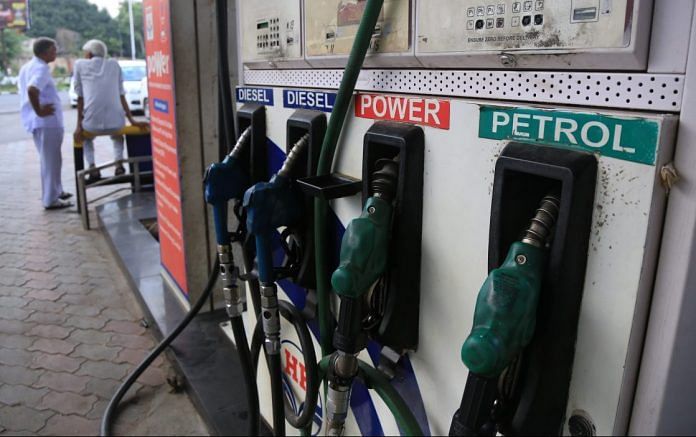New Delhi: Petrol and diesel prices touched an all-time high this week. For instance, in Delhi, the petrol price rose to Rs 85/litre and the diesel price Rs 78/litre.
Meanwhile, as ThePrint’s Editor-in-Chief Shekhar Gupta noted in episode 668 of Cut The Clutter, prices of crude oil worldwide had fallen to an all time low.
“And yet our petrol and diesel prices are going higher and higher and higher and many of you are complaining that the Modi government doesn’t seem bothered,” he remarked.
How is fuel taxed?
Revenue from the sales of petrol and diesel is among the highest sources of revenues for both the central and the states governments.
“So, you find many opposition parties make noises about fuel prices going up, but beyond that, they don’t escalate it too much, because they also benefit because they also keep upping their VAT or value added tax, accordingly,” Gupta noted.
In fact, fuel along with liquor has been kept out of the purview of the Goods and Services Tax. But while liquor is taxed by the state government, fuel is taxed by the central government in the form of indirect taxes.
During the Congress-led UPA government, prices of crude oil had gone up to $142 per barrel — today, it stands at just $52 per barrel.
Also read: Petrol, diesel prices rise for 7th day in a row, rates go up by about half a rupee
Prices in other countries
Gupta also listed out the price of fuel in other countries. In Qatar, the price of petrol is Rs 27, a third of what is charged in India. In the US, it is Rs 52 — 60 per cent of what it is in India.
China’s rate at Rs 75/litre is comparable to India’s. In Pakistan, however, the price is Rs 50/litre, in Sri Lanka it’s Rs 61/litre, in Nepal it’s Rs 68/litre and in Afghanistan it’s Rs 37.50/litre.
“Now it is not as if India has the most expensive fuel in the world. Look at some other countries — Poland Rs 90, Japan Rs 94, South Korea Rs 96, UK Rs 118, Germany Rs 119, France Rs 126, Syria Rs 150 … and Hong Kong looks like the most expensive fuel in the world that is equivalent to Rs 173,” Gupta said.
Explaining what goes behind the pricing structure, he said that crude oil is brought globally at the same price following which, there is refinery costs to render it into different products including petrol.
“But then governments tax this fuel. They tax it for revenues, which are very important for the government, and many like those in Europe, tax it — a carbon tax by way of discouraging people from using private vehicles,” he said.
The carbon tax, however, is a practise seen in richer countries. So how come India has prices that are comparable to these countries, asked Gupta.
The China example
To answer the question of why India’s prices are comparable to those of richer countries, Gupta used the example of China that also has higher prices.
The first reason is that China and India import most of their hydrocarbons. “So it is important for them to keep prices on the higher side, so the consumption doesn’t go up too much because if it does, their import will go up,” said Gupta.
Secondly, the Modi government has figured that an easy way for earning more for the exchequer is to keep raising taxes on fuel. The government had in fact managed to raise the total excise collection from Rs 99,000 crore per year to Rs 2.4 lakh crore per year within two years of the UPA government losing power at the Centre.
“So, as the price went down, the increased excise… on your petrol price did not come down,” Gupta said and added, “And later when crude prices started going up, the price at which your petrol pump gets the fuel from the refinery also went up — the Modi government did not reduce the excise.”
“…it is not wrong to say that Modi government has not passed on the benefit of low crude prices to the consumers. If anything, they have further taken money out of the consumers pocket by continuing to raise these excise taxes,” Gupta said.
Also read: Covid fear, high taxes push India’s petrol consumption to overtake diesel
What fuel taxes mean for India
Breaking down the excise tax on fuel Gupta said that if you buy a litre of petrol or a litre of diesel, 63 per cent of what you pay on your petrol, i.e. Rs 52.50 and 58% or Rs 42.70 on what you pay for diesel goes towards taxes.
Nineteen per cent of these taxes, on an average, go to the states and the rest to the Centre.
In the financial year, 2019-2020, the Modi government collected a total of Rs 3.39 lakh crore in the form of excise duty — about twice as much as what had been collected by the UPA government six years ago.
In 2014-2015, states had collected Rs 1.6 lakh crore in excise collections, which is at Rs 2.21 lakh crore now — a 100 per cent increase.
“When, under the UPA, fuel prices went up a little bit, there will be people out on the streets, TV channels going berserk… today you see none of that,” commented Gupta.
He concluded by saying “What the Modi government is doing is a Robin Hood act i.e., rob the rich and distribute it to the poor.”
Watch the latest episode here:



